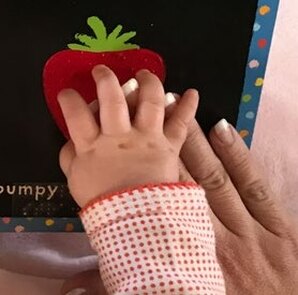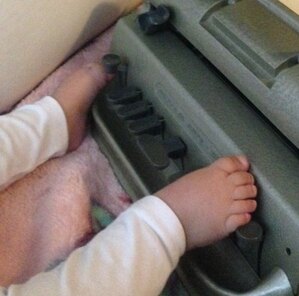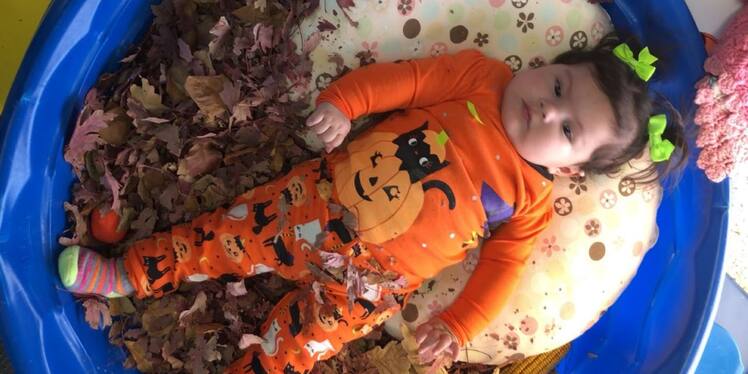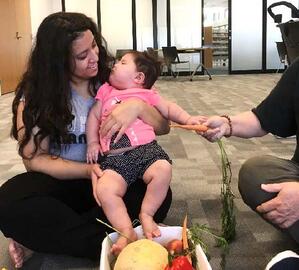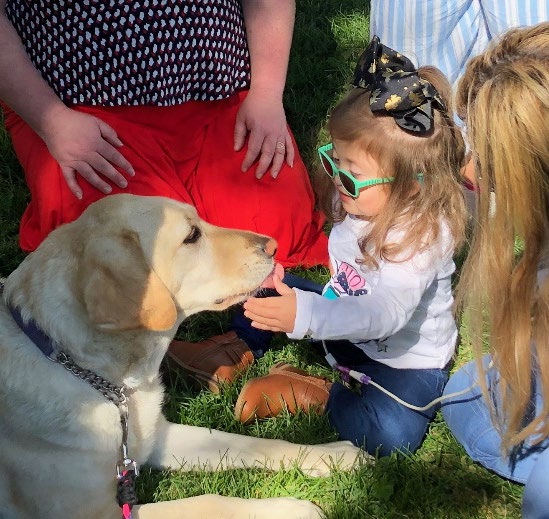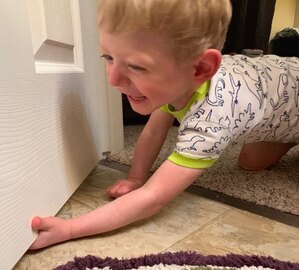Basic Strategies for Engaging with Children (birth to age 3) with Blindness or Visual Impairment
Click HERE for PDF in espanol.
Children who are blind or visually impaired learn about the world differently. Here are ten basic strategies to help providers and caregivers build trusting relationships with these children. Ensuring positive interactions is key to helping children become active learners and fostering their independence.
#1. Hand Under Hand
Giving a child the choice to participate in an activity promotes independence by allowing them to become an active learner rather than a passive participant.
#2. Feet First
Once the child is comfortable with the new object at their feet, it can slowly be moved up to the hands for hand under hand or independent tactile exploration. Fun tip: place mylar paper under child’s feet to teach simple cause/effect – it makes great crinkly noises with very little movement required from the child.
The feet first technique works well for sensory play and bath time. Put water (or sensory materials such as dry beans, rice, water, shaving cream, etc.) on a cookie sheet or in a shallow container and place near the child’s feet. If the child is hesitant, touch it together using a hand-under-feet approach or gently sprinkle a few drops on the child’s feet. Go slow! Once your child feels comfortable with the sound and feeling you can slowly place their feet directly into the water. #3. Boundaries
Vision is a synthesizing sense – it gives us information in a split second about many things happening in the environment. Without immediate access to this information, children with visual impairments may not feel safe to move around and explore. Use of physical “boundaries” tells a child “where they are” in any given space and helps create a feeling of comfort and security.
Create physical boundaries (a “workspace”) to define an area in which your child can safely play and explore. Starting with a small space such as an empty laundry basket or plastic swimming pool. with some of their favorite toys creates a feeling of safety and familiarity. Boundaries can be as simple as sitting your child with his back against the couch and putting toys in front of them. #4. Wait Time
Infants and toddlers have limited control over what happens during their daily routines. Creating opportunities for active participation in a play and other activities is essential for encouraging communication and promoting self-initiation. Wait time is about waiting for child to make a move rather than relying on an adult for prompts and guidance.
Try this: start an activity your child enjoys (banging a drum, bouncing on your lap, singing a song). After a minute or so, stop the activity and say something like “would you like more drum?” Quietly wait for the child to respond with a sound, gesture, or movement. (This may take up to 30-60 seconds while you silently count in your head but don’t give up!) Wait time allows your child an uninterrupted opportunity to decide if they’d like to continue with the activity and then problem solve “what to do next” in order to continue. Assume any movement or sound is an indication that your child would like to continue the activity and immediately respond. “You (said ‘aah,’ kicked your leg, moved your hand), you’re telling me ‘More drum’!” and then bang the drum a couple of times. With patience and practice your child will learn the power of their movements/sounds – a key for communication! Wait time will also give you time to read your child’s cues. (See “Reading Child’s Cues below.) #5. Sensory Learning
The next time, you may beat the drum softly while your child touches the drum with his hands or feet to feel the vibration.
The third time, your child may be ready to bang the drum (either by themself or with your help using the hand under hand technique). #6. Verbal Descriptions
Children who are visually impaired cannot rely on visual information alone to understand the world around them. Verbal descriptions from an adult or peer are an important tool to give meaning and context to the experience a child is having in the moment.
For young children, simply labeling what they are doing gives valuable information. “Shake, shake, shake! You’re shaking the maraca!” Emphasizing words to identify sensory information is also helpful, “You hear the dog barking!,” “That popsicle is cold!” Pair words with objects or activities happening in the moment to make your descriptions meaningful. “We’re pulling your shirt over your head Your shirt is red!” Stay focused on the specific activity to avoid confusing your child. During mealtime, use descriptive words about the taste of the milk or its temperature, or explain how your child is drinking it out of a cup – not about what sound a cow makes. It is OK to use “seeing” words such as “look at the red truck!;” some children “look” with their hands. Also, give a warning about what’s going to happen next during an activity, e.g., “I’m going to pick you up! One, two, three … UP!” This will help your child anticipate the change and be ready, rather than startled, by it. #7. Opportunities for Communication
As parents and caretakers, it is up to us to create opportunities for a child to communicate but we must also pay attention to how a child communicates with us!
Communication isn’t always vocal; we often understand what others are telling us just by watching their body language. Encourage your child’s attempts to communicate by recognizing their sounds and gestures in the same way you would if they were using words. Use turn taking in communication. Repeat sounds a baby makes or put words to what they’re trying to tell you: say “Throwing blocks means ‘all done’!” Be respectful of your child’s choice. Even if you cannot honor their request, acknowledge that you heard your child (“You want your car, but it’s time to eat” or “First diaper, then books”). Try this: “interrupt” an activity by stopping in the middle to give your child an opportunity to indicate they want more (singing or swinging are easy ones to start with). When your child vocalizes or moves their body, assume this is a request to continue the activity (see Wait TIme strategy above). Children learn best when they are active participants in a game, routine, or activity. #8. Reading Child's Cues
Actions are often worth a thousand words, but these “cues” vary widely from child to child, as well as situation to situation. A child who is visually impaired may use their bodies in ways we misinterpret so it’s important to take time to understand what they are trying to tell us.
If we’re not responsive to a child’s attempt to communicate, they may quit trying to express themselves or learn that they must wait for an adult to prompt their participation in an activity. (Refer to Opportunities for Communication and Wait Time above.)
#9. Use Real Objects
For children who are blind or visually impaired, concept development, or an understanding of “big ideas” happens only through a variety of hands-on, multi-sensory experiences.
Only after your child has whole concepts can they begin to understand representations of objects through comparisons (both the real and toy cars have four round wheels; which car is bigger? which one can you ride in?)
#10. Routines and Repetition
For example, playing with a ball is better than just touching a ball. When rolling a ball back and forth, a child can anticipate when the ball is coming toward them or rolling away from them. By touching the ball and handling it in different ways, they learn about size, texture and weight, how to make the ball roll fast or slow or how to make it bounce.
Learning cannot be left to chance. Specific communication skills (see Opportunities for Communication above.) can tie the experience to larger concepts, and the give and take of playing ball with a partner is shared joy. |
A Shared Vision: Partners in Pediatric Blindness & Visual Impairment
EIN 81-4227664

